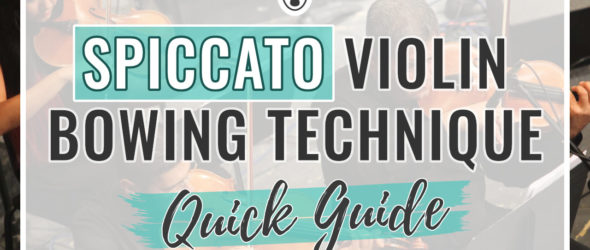Let’s see what spiccato is and how you can master it on the violin!
What Does Spiccato Mean in Music?
Spiccato is a bowing technique for violin and other instruments in the violin family. In this type of bowing, the bow bounces lightly on the strings as it quickly moves up and down. Spiccato is usually used in quick pieces or passages.
The spiccato technique has some similarities with the staccato and sautillé bowing techniques so the terms often get confused. Read on to learn how to play spiccato and find out how it differs from the other techniques!
Examples of Spiccato in the Violin Repertoire
First, let’s listen to some examples of spiccato in violin pieces.
- Grażyna Bacewicz – Oberek
Here you can hear double-stopped spiccato throughout almost the whole piece.
- Caprice no. 9 by Niccolò Paganini
- Haydn, Symphony No. 94, commonly known as “Surprise Symphony”
At the beginning of the second part, andante, you can hear slow spiccato.
What Is the Symbol for Spiccato?
Usually, the symbol used for spiccato is a dot above or below the notes, just as for staccato. Sometimes you may find a staccatissimo sign instead (it looks like a small wedge), or no additional signs but the word “spiccato” above the notes.

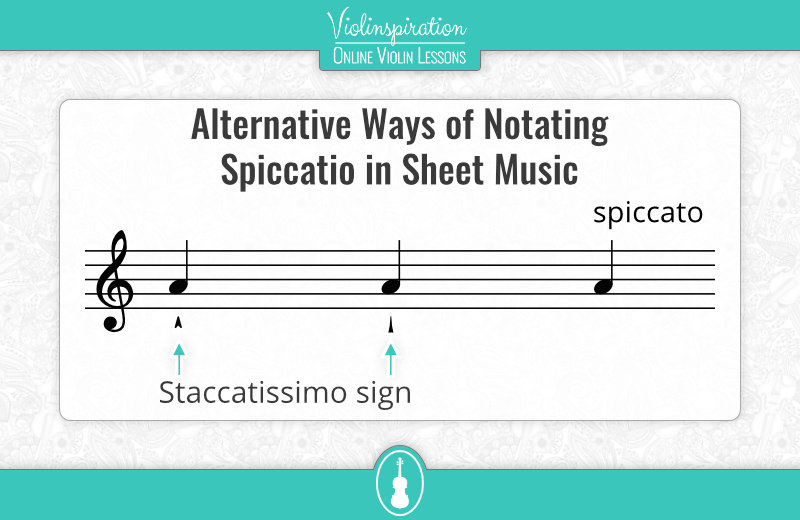
Historically, the dots were used to indicate various techniques up to the point where Western music education started to take the form we know today during the classical period. But even then, sometimes composers used symbols as they saw fit so there’s still some confusion about what exactly a dot means in the sheet music.
Spiccato and other similar bow techniques are a tool in the violinist’s arsenal and can be used according to what they are trying to achieve in a given piece. So if a note has a dot above or below, choose the bowing technique that feels right to you.

How to Play Spiccato on the Violin
Now, let’s have an in-detail look at how you can learn to play spiccato on your violin!
1. Choose the right spot on your bow
When it comes to the bow placement, spiccato is usually played at the lower third of the bow – about the balance point or a bit closer to the frog.
You can do spiccato on the rest of the bow too. However, this is not the common way, and it is usually used as an effect. For example, if you have one note spiccato and you don’t want to use loud dynamics, or if you’re playing left-hand pizzicato while using an occasional spiccato note, you may use the middle of the bow for spiccato.

2. Learn to bounce with the bow
The bow should bounce for each note – one note on the down bow, one on the up bow on repeat.
To do a spiccato bow stroke, keep your bow just above a string and let it fall on it. The bow should fall in the direction you’re going to play, a down bow or an up bow.
When it touches the string, apply a bit of bow pressure and immediately release it. Your left hand and especially your thumb should be very relaxed.
After the note is played, lift your forearm a bit and bring it up to the previous position. Take advantage of the bouncing bow to make the notes sound sharp and short.
3. Adjust the tempo – start slowly, speed up bit by bit
Start by practicing very slowly on open strings. When you feel comfortable, try to speed up the bow bounces.
4. Practice playing scales with the spiccato bow stroke
When you’re ready, incorporate the new technique in playing scales that you already know very well, so you won’t have to concentrate on the notes but on the bow motion.
Download two easy spiccato scales over here:
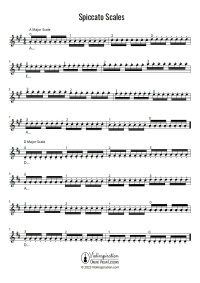
Free Violin Sheet Music
Spiccato Scales
5. Add etudes to your practice
You can find many exercises with the spiccato bow in the etude books. The one I’d like to recommend to you is variation no. 10 from Sevcik, op. 3.
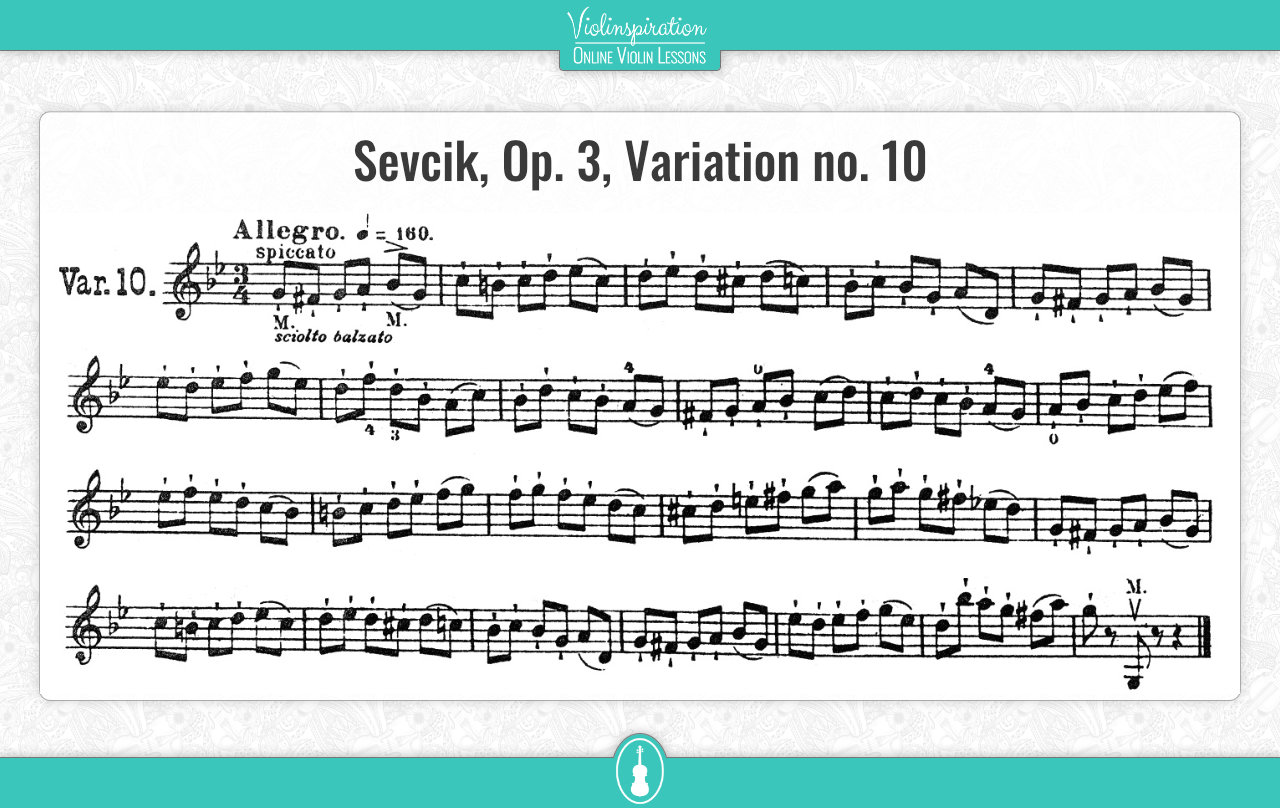
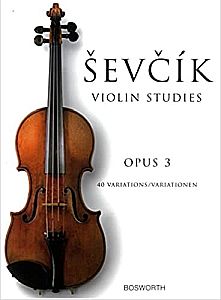
Bonus tip
Except for practicing the bow stroke itself, watch performances of well-known violinists and study their moves while they play. You can learn a lot just by looking at a performance very carefully.
What is the Difference Between Staccato and Spiccato?
Staccato and spiccato are both techniques of playing short and sharp bow strokes. The main difference is that spiccato makes use of the bouncing bow to make the notes sharp, while in staccato the bow is abruptly stopped, cutting the note’s duration in half.
In the notation, both techniques are using a dot above or below the notes. It means that depending on the music piece, the era, and other factors, each performer should decide which of the two is the best for the purpose needed.
What is the Difference Between Spiccato and Sautillé?
Spiccato can be used for slow and mid-tempo, but sautillé is only used for fast tempo. There is no strict rule, but anything faster than 100 BPM should be considered sautillé but it’s also a matter of interpretation.
Sautillé is a similar bouncing bow technique, but the bow shouldn’t bounce too high. If it does, it’s either a flying staccato or a flying spiccato.

Sautillé doesn’t have a dedicated symbol. Like staccato and spiccato, it is marked with dots above or below the notes. Often it is left to the performer’s interpretation.
Summary
Spiccato is a very useful technique and a great tool for violinists. It is used quite often, especially in the classical repertoire, romantic, and in modern compositions. You might find yourself use it a lot while playing e.g. Mozart’s pieces.
You can use this technique when you need to make your staccato stroke more elegant, instead of the abrupt stop, as long as it fits the whole composition.
I hope that this post helped you learn how to play spiccato on your violin!
